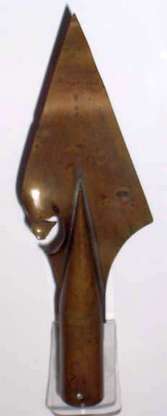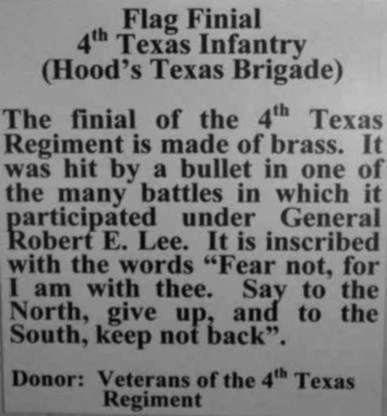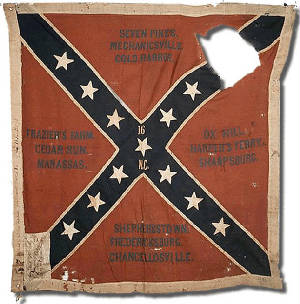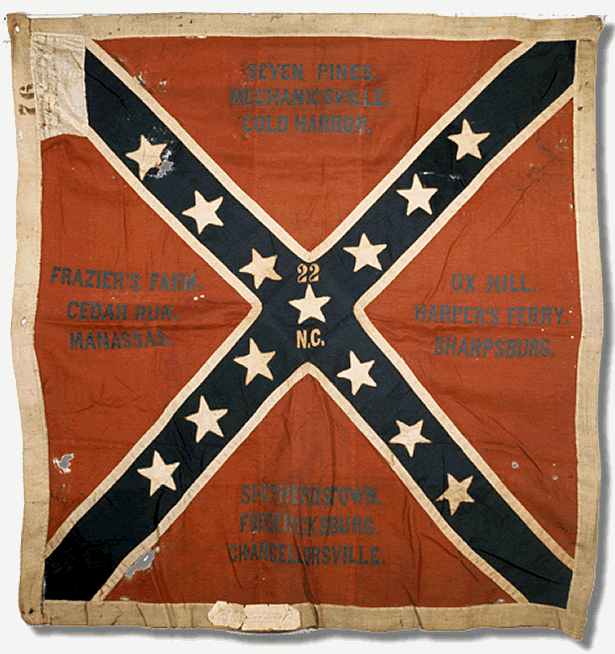|
Flags of the Civil War
Civil War Flag History
FLAG HOMEPAGE
What was the purpose of the Civil War flag?
In military organizations during the Civil War, flags, commonly known as
colors* (spelled also as colours), standards or guidons, served to: specify the rallying point for
troops; and to identify and locate the commander.
What is the difference between a Civil War flag and guidon?
Guidon is the name given to a small flag or pennant carried as a standard
by a military unit. The Civil War guidon, usually made of silk, was the military standard carried by cavalry, known as
troops, artillery batteries, and by some infantry units. The guidon signified unit designation and corps affiliation.
A basic guidon was usually rectangular, but sometimes had a triangular portion removed from the fly (known as "swallow-tailed").
Cavalry troops carried the "swallow-tailed" flags on horseback with the "V" of fabric cut away, making the flag lighter and
less resistant to wind. The Civil War flag, known as colors or standard, was generally made of wool and carried into
battle by units which did not carry guidons. Although infantry regiments primarily used flags, some infantry companies
and regiments carried silk guidons. While each infantry company (ten companies formed a regiment) carried its flag
into battle, the regimental flag was the rallying point.
| Civil War Flag Finial |

|
| 4th Texas Regimental Flag |
| Texas Civil War Flag |

|
| Texas Brigade Flag History |
The Civil War flag on the battlefield
On Civil War battlefields, regimental colors or flags provided an important
means for soldiers to mark the positions of their regiments and for their officers to convey instructions to the men under
their command.
One can almost hear Leonidas shout, "BATTLE FORMATION!"
Flags employed during war are as old as war itself. An organized and trained army would
employ various formations in combat, so each regiment's ability to maintain its position during battle was critical to
the army's success. A victorious army was a cohesive, coordinated fighting force on the battlefield, but the
unit was subjected to an atmosphere of roaring artillery and discharging weapons, thus making it difficult
to see and hear. As the regiment marched toward its objective, the intolerable noise and billowing smoke made it impossible
to see beyond a few yards or to hear the commander's orders, so the flag was the rallying point.
Each regiment had a color company or a color guard, whose assignment was to
bear the colors into battle and protect them. Each member of a color guard or company was selected for this position based
on his courage and steadiness under fire, by the regimental commanders. The flags were carried by unarmed color sergeants,
and accompanied by armed color corporals, who were instructed not to engage in combat unless the flags were in immediate danger
of capture, The flags became the physical symbol of a units pride and courage, a rallying point in combat and the source of
many heroic deeds in their defense.
What was the primary purpose of the Civil War flag during battle?
The purpose of the Civil War flag was the same for both Union and Confederate
armies. The regimental flag was an integral part of the unit by serving as the focal point for soldiers during
battle. Commands were often conveyed to the soldiers by musicians, but the colors, carried by the guide, signaled
each movement to every soldier in the unit. The flag was vital to the army's coordinated movements, so the enemy intentionally
aimed at the guide or color bearer making it common for 3 or 4 standard bearers to fall in a single battle.
(A similar principal was applied to cavalry and artillery, because soldiers shot the horses to immobilize the enemy.)
There were more medals of honor bestowed on soldiers for capturing the enemy's
colors than for any other action during the Civil War. Many historians and authors often graphically describe how
a single soldier heroically captured the enemy's flag, while describing the pinnacle event as more than humiliating
and embarrassing for the flagless unit. But colors were not merely blissful tokens and trophies of war nor were
they symbolic colorful clothes wavering across smoke filled battlefields. Yes, men and boys from the same community
proudly gripped the standard made by local women, and yes while each flag bearer fell casualty to enemy shot and
shell, another soldier eagerly snatched the blood stained standard from the fallen while continuing to
advance into grape and canister shot, but regimental colors was vital to each unit's movements during battle, and the primary
purpose of the regimental colors was to communicate movements to every soldier in the regiment. When the color bearer, also
known as guide, obeyed a command, i.e. left oblique, the soldiers in the regiment would view and then march in the direction
of the flag. Often times soldiers to the rear were unable to see the colors, so they merely followed the movement
of the soldier directly to his front.
Modern warfare tactics do not call for rallying points in the open, with
large numbers of men performing intricate maneuvers. Therefore, today's armies use colors in ceremonies but do not carry them
into battle.
The Flag
Colors were often inscribed with the unit's designation, and names of battles
or other symbols representing former achievements. During the Civil War, unique flags were assigned from the highest
level, headquarters, to the basic fighting unit known as the company (ten companies to a regiment), which was generally
raised from the same community. Many Civil War flags were meticulously designed and sewn by women in the local communities
where the companies were recruited, so the flag proudly represented their loved ones, their local community, as well
as their nation.
| Confederate Civil War Flag |

|
| Confederate Civil War Battle Flag |
Where are the Civil War flags today?
After the war, 545 captured Confederate flags were held by the U.S. War
Department in Washington, D.C. These flags were stenciled with a number in black ink and, in some cases, capture histories
were handwritten on linen tags sewn onto the flag. Detailed records were kept so that the government could award the (Congressional)
Medal of Honor for capturing an enemy flag. Today, these records, detailed in the National Archives’ Register of Captured
Flags, are valuable tools for historians.
In 1905, Congress passed legislation returning the captured flags to the
Southern States. The Museum of the Confederacy was the recipient of the Commonwealth of Virginia’s 75 repatriated flags.
In 1906, another 252 flags from unidentified Confederate units were also entrusted to the Museum, creating the world’s
largest collection of wartime flags.
| Civil War Regimental Flag |

|
| Confederate Regimental Flag |
(Right) 22nd North Carolina Regimental Flag. Both flags pictured on this
page are discussed in the links section below.
Loss of Colors
There is no official definition of the term "loss of colors." However, the
term, in common usage, refers to the capture of a unit's colors (flags) by the enemy in battle, or the taking away of a unit's
colors as a punishment or disciplinary measure.
"Colors" or unit standards have historically served as a means of identifying
units of the battlefield. During the Civil War, men were trained to follow their colors in battle, to "rally" around them,
and generally to use them to maintain unit cohesiveness. Unit colors were a great source of pride, and victories or defeats
were often expressed in terms of colors being captured from or lost to the enemy. During the Civil War, many awards of the
Medal of Honor were made for the capture or defense of colors. Even then, however units which lost their colors remained intact
and continued to fight.
Use of military flags today
*The terms colours and colors are often but not always interchanged.
Colours is of British origin, but over centuries the Americanized form of the word known as colors was adopted by
the armed forces of the United States. American English has a tendency to shorten British English. Other examples
include most words ending in an unstressed -our in British English (e.g. colour, flavour, harbour, honour, humour, labour,
neighbour, rumour) but end in -or in American English (color, flavor, harbor, honor, humor, labor, neighbor, rumor).
(Credits and related reading listed at below.)
Recommended Reading: The Flags of
the Confederacy: An Illustrated History. Description: Devereaux D. Cannon is an expert on vexillology
(the study of flags). This book offers a history, profiles, design specifications and an overview of the various flags (national
flags, battle flags and naval ensigns) that were utilized by the Confederacy. The book features several pages with glossy
photos of the various flags of the Confederacy. It features even the little known flags. Continued below...
Cannon's book has inspired flag makers to revive the old flags
in addition to the 3 national flags, the battle flag and the naval ensign. This book is must have for flag gurus, Civil War
buffs and southern partisans.
Recommended Reading: The Confederate Battle
Flag: America's Most Embattled Emblem. Description: Few emblems in American history have provoked stronger
passions than the battle flag of the vanquished Confederacy. To some it symbolizes honor and independence; to others, hatred
and slavery. This highly charged icon has finally found the fair and fact-based treatment it so desperately needs. John Coski
probes every aspect of the flag's complex history, from Civil War to Civil Rights, from rebel icon to NASCAR kitsch. As readable
as it is incisive, The Confederate Battle Flag shows how reactions to the banner have revealed fault lines in our culture
from Appomattox to the present day. Continued below...
Reviews:
Few emblems in American history have provoked stronger passions
than the battle flag of the vanquished Confederacy. To some it symbolizes honor and independence; to others, hatred and slavery.
This highly charged icon has finally found the fair and fact-based treatment it so desperately needs. John Coski probes every
aspect of the flag's complex history, from Civil War to Civil Rights, from rebel icon to NASCAR kitsch. As readable as it
is incisive, The Confederate Battle Flag shows how reactions to the banner have revealed fault lines in our culture from Appomattox
to the present day.
--Tony Horwitz, author of Confederates in the Attic (20050502)
At last we have a dispassionate history of that passionate symbol, the Confederate
battle flag. John Coski has dispelled myths held by both supporters and opponents of the public display of the flag. Blending
cultural history and the history of memory in a lucid manner, he has written a definitive account of the numerous 'flag wars'
in both South and North during the past century and more.
--James M. McPherson, author of Battle Cry of Freedom: The Civil
War Era (20050424)
This book is a sorely-needed and unique achievement--a deeply researched,
scholarly treatment of the Confederate battle flag and its many meanings over time. With an engaging writing style fully accessible
to general readers, with international sweep, and with great sensitivity, Coski brilliantly shows that the battle flag is
the 'second American flag,' fraught with both racism and endless popular uses across borders that no one can expect to control.
--David
W. Blight, author of Race and Reunion: The Civil War in American Memory (20050522)
This splendid book is more than timely--it's long overdue. Coski shows how
a flag originally designed to avoid confusion has become a sort of Rorschach blot. It still identifies partisans, but often
they seem to be fighting different wars. Whatever the flag means to you (valor, bigotry, and boogie-till-you-puke are just
three of the possibilities) you'll learn something here.
--John Shelton Reed, co-author of 1001 Things Everyone Should
Know About the South (20050403)
Coski presents a cogent history of the Confederate flag and the controversies
surrounding it in the post-Civil War era...While some see it as emblematic of racism, to others it represents historic tradition.
--Grant
A. Fredericksen (Library Journal 20050723)
In his comprehensive new book, John M. Coski chronicles the rich history
of the so-called second American flag...[He passes] along a plethora of surprising stories, anecdotes, economic statistics,
and editorial quotations regarding the flag. As a result, Mr. Coski's book is ultimately worth reading. Mr. Coski's meticulously
researched book boils down to a simple truth: The Confederate flag means different things to different people.
--Felix
Gillette (New York Sun 20061001)
John Coski...has given us the first documented consideration of the dispute
over the appropriate use of what he calls 'the second American flag,' and he begins by dispelling a number of historical misconceptions
about its origins and identity.
--Edwin M. Yoder Jr. (Weekly Standard 20071009)
In his richly detailed book The Confederate Battle Flag, John M. Coski calls
that very familiar symbol of the Old South 'America's most embattled emblem' and he is no doubt right. Is there any icon of
the American past more beloved and at the same time reviled than the star-studded diagonal blue cross against a red background...Mr.
Coski's book is not just about recent debates over the flag. It is about its whole history.
--Steve Goode (Washington Times)
No symbol in the past few decades has been more divisive than the Confederate
battle flag. In his important new book, The Confederate Battle Flag, John M. Coski shows how it got that way. The battle flag,
though not the official banner of the Confederacy, emerged over the course of the war as the sentimental favorite among Confederate
soldiers and civilians alike. Coski takes the story forward from there, but his most important contribution is his recounting
of the tumultuous story of the flag in the second half of the 20th century, when the civil rights movement emerged, setting
loose a variety of groups that made competing claims over the meaning of the flag--and the meaning of the war...Coski's book
will speak to the flag's opponents as well as its defenders, but his most inspired message is aimed at those cheerleaders
who insist that the flag has one, unchanging, fundamentally benign meaning. He shows that the history of the flag is simply
too complicated for anybody to reach such simplistic conclusions...The depth and breadth of his research give his book real
authority, and future disputants on both sides will have to reckon with his clear, reliable conclusions.
--Joseph Crespino
(Washington Post Book World)
John M. Coski's history, The Confederate Battle Flag, brings some needed
rationality to a debate driven by the raw emotion of soul injury.
--Diane McWhorter (New York Times Book Review)
If you'd like to dazzle your friends at the next cookout with what you know
about the much-misunderstood Confederate flag, Coski's book is for you...Go ahead. Bring up the subject of the flag and then
stand back. But if you have Coski's book under your arm, you might be able to turn the debate into something more than just
finger-pointing.
--Linda Wheeler (Washington Post)
Whether you love or hate the flag, after reading Coski you will love it
or hate it in a different way.
--Theo Lippman Jr. (Savannah Morning News)
A book that explains its history has been long needed, and now John M. Coski
has written a very good one which everyone on both sides of the controversy over the flag should read and appreciate. Coski
provides a well-researched, clearly presented, and most important of all, scrupulously fair account of the history of the
battle flag and the controversies surrounding it, one that avoids polemics and strives to be true to the historical record.
The Confederate Battle Flag is a splendid example of how a careful scholar can contribute to an important public debate.
--Gaines
M. Foster (Civil War Book Review)
This is a solid and well-researched book. Coski's work is very much in the
spirit of...David Blight's Race and Reunion. It is another excellent look at the history of Confederate memory.
--Richard
R. Hourigan III (Southern Historian)
John M. Coski has given us a well-researched, clearly written history of
the Confederate battle flag and how it became "America's most embattled emblem."...From Mississippi to Georgia to South Carolina
to Alabama and well beyond, Coski provides a meticulous account of the flag's rapid installation as an institutionalized emblem
of recalcitrant racism and defiance of federal authority.
--James C. Cobb (Journal of American History)
John M. Coski has written the first full published assessment of the changing
role played by the Confederate battle flag in American history. It is a thoughtful, methodical account of how the starred
blue diagonal Cross of St. Andrew on a red field eventually came to be regarded as the preeminent symbol of the would-be southern
nation...Coski argues convincingly that use of the emblem was relatively infrequent and uncontroversial until it was adopted
in semiofficial fashion by the 1948 Dixiecrat convention in Birmingham, Alabama. Thereafter the battle flag was associated
closely in the public mind with the fight against integration--a linkage responsible for the so-called flag wars of recent
years, the diversity and complexity of which Coski details with admirable clarity and fair-mindedness.
--Robert Cook,
(Journal of Southern History)
The St. Andrew's cross battle flag--a star-studded blue diagonal cross on
a red field--continues to this day to stir fierce emotions. In this deeply researched, dispassionately argued, and ultimately
wise book, John M. Coski provides a careful history of that flag, its uses, abuses, and meanings...As the nation continues
to debate the meaning of the Civil War, The Confederate Battle Flag provides badly needed historical and ethical clarity about
one of the most provocative symbols of that war.
--James L. Roark (Civil War History Journal)
Coski does not move from a survey of "the modern debate" (which he shows
to be several debates) into a discussion of the aspects calling for contextualization and analysis. Instead, he provides a
biography of the battle flag from 1861 to the present. He carefully examines the claims about its history that have been sharply
contested over the last fifteen years, but his narrative is most valuable for the wider perspective it offers in tracing the
path by which the Confederate battle flag became a symbol prominent enough to sustain such vigorous controversies...This story
provides a fresh background to the recent "flag wars" that Coski ably recounts in his final section. As he recognizes, these
contests have taken a variety of forms that might be grouped into two basic categories. The first set has concerned the rights
of individuals to display the emblem in schools or on license plates or in other regulated forums. The second set has revolved
around governmental rather than individual expression, particularly in state flags or on statehouse grounds or at public schools
and colleges...By moving analysis of the flag debates beyond the terms chosen by its participants, Coski achieves a stimulating
success in his aim to help readers understand the controversies.
--Thomas J. Brown (South Carolina Historical Magazine)
The battle flag is enigmatic, its history has been clouded by political
debate, and it is often referred to, erroneously, as the "Stars and Bars." John M. Coski's analysis of the flag's history,
its uses, and its various meanings, therefore, is both welcome and needed.
--Karen L. Cox (American Historical Review)
Utilizing contemporary sources through newspapers and magazine articles,
as well as primary sources such as diaries, Coski has produced a fascinating work delivered with a remarkable absence of passion
involving a topic that generates seemingly little else...Coski has performed a valuable service in shining a dispassionate
and informing light on the topic.
--Robert Sampson (H-Net Online)
Recommended Reading: The
Flags of Civil War North Carolina. Description:
Compiled and written by educator and Civil War expert Glenn Dedmondt, The Flags Of Civil War North Carolina
is a very straightforward reference presenting photographs, color illustrations, descriptions and history of the titular flags
that flew over North Carolina when it seceded from the Union.
Each page or two-page spread features the different flags of the various North Carolina
regiments. A meticulously detailed resource offering very specific information for history and civil war buffs, The Flags
Of Civil War North Carolina is a welcome contribution to the growing library of Civil War Studies and could well serve as
a template for similar volumes for the other Confederate as well as Union states. Great photos and illustrations! Continued
below.
Flags stir powerful emotions, and few
objects evoke such a sense of duty and love for the homeland. In April 1861, the first flag of a new republic flew over North Carolina.
The state had just seceded from the union, and its citizens would soon have to fight for their homes, their families, and
their way of life. Each flag is meticulously
detailed and scaled to perfection. The Flags of Civil War North Carolina
is the history of this short-lived republic (which later joined the Confederacy), told through the banners that flew over
its government, cavalry, and navy. From the hand-painted flag of the Guilford Greys to the flag of the Buncombe
Riflemen--made from the dresses of the ladies of Asheville--this
collection is an exceptional tribute to the valiant men who bore these banners and to their ill-fated crusade for independence.
About the Author: Glenn Dedmondt, a lifelong resident of the Carolinas and member of the Sons of
Confederate Veterans, shares his passion for the past as a teacher of South Carolina
history. Dedmondt has also been published in Confederate Veteran magazine.
Recommended Reading: "Why I Wave the Confederate Flag, Written
by a Black Man". Description: Congress shall make no law respecting
and establishment of religion, or prohibiting the free exercise thereof; or abridging the freedom of speech, or of the press;
or the right of the people peaceably to assemble, and to petition the Government for a redress of grievances. "This book is
about truth and passion." What makes this book dangerous is its raw honesty. Hervey lifts the veil of Black
decadence at the same time he exposes the lies and political correctness of modern day America. Continued below.
Hervey states: "I show that
the Civil War was not fought over slavery and that the demise of my race in America is not of the White man, but rather of
our own making. In this book, I show how Blacks in America ran away from physical bondage to one far worse-- mental bondage."
Recommended Reading: Confederates in the Attic: Dispatches from the Unfinished Civil War. Description: Pulitzer Prize-winning journalist
Tony Horwitz returned from years of traipsing through war zones as a foreign correspondent only to find that his childhood
obsession with the Civil War had caught up with him. Near his house in Virginia, he happened to encounter people who reenact
the Civil War--men who dress up in period costumes and live as Johnny Rebs and Billy Yanks. Intrigued, he wound up having
some odd adventures with the "hardcores," the fellows who try to immerse themselves in the war, hoping to get what they lovingly
term a "period rush." Horwitz spent two years reporting on why Americans are still so obsessed with the war, and the ways
in which it resonates today. Continued below.
In the course of his work, he made a sobering side trip to cover a "murder that was provoked by the display
of the Confederate flag," and he spoke to a number of people seeking to honor their ancestors who fought for the Confederacy.
Horwitz has a flair for odd details that spark insights, and Confederates in the Attic is a thoughtful and entertaining
book that does much to explain America's continuing obsession with the Civil War.
Credits: Texas Civil War Museum; Museum of the Confederacy; North Carolina
Museum of History.
|

